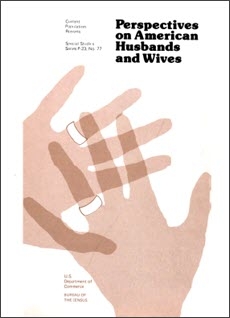Perspectives on American Husbands and Wives
Perspectives on American Husbands and Wives
Introduction
This report presents an analysis of the demographic and economic characteristics of married couples. The study is based both on a new set of tables that permit an examination of the joint characteristics of husbands and wives, and on information that was already available from existing data sets.
In the past few years, Census Bureau reports on the current composition of the American household and family have tended to emphasize such changes as increases in the number of persons living alone, gains in the number of unmarried couples, and the growing proportion of mothers maintaining one-parent families. As striking as the growth of these groups has been, only a minority of the total population is likely to experience any of these types of living arrangements for more than a short-term interval. Often that interval is a transitional period between marriages or a period that precedes or follows the far more universal living experience of marriage.
Past history indicates that almost everyone will be either a husband or a wife at some point in their life. Typically, a person who has entered a marital union will stay in that union for the remainder of their life, although a growing proportion will not. Similarly, most of these married persons will eventually have children, or take a job, or both, although some husbands and wives will forego one or both of these options.
Traditionally, most married women, and particularly those who were mothers, have accepted the demands and rewards of work inside the home. Only the husband was encouraged to continue his education, or enter the labor force, and thereby provide most, if not all, of the family's income. As long as this situation continued, it was perhaps not surprising that many persons considered it sufficient to describe the social and economic status of the family by referring only to the characteristics of the husband—his education, his occupation, his income, etc.
Today's wives, however, are increasingly likely to have completed high school and perhaps some years of college, to participate in the labor force, and to contribute to the family income. Thus, the demarcation between many of the roles of husbands and wives has become less distinct. The sole breadwinner has given way in many instances to dual breadwinners. Similarly, many working wives and mothers are coming to expect more involvement and assistance from their husbands in carrying out the childrearing and housekeeping responsibilities of the family.
In light of these developments, total reliance on the characteristics of the man when describing married couples is likely to result in misleading conclusions which do not always correspond to reality. A recent report to a United Nations conference on the revision of concepts related to family and household data pointed out that it is still sufficient to describe single-parent families in terms of the age, sex, employment status, occupation, etc., of one person. This approach, however, is no longer appropriate with married couples, for the life patterns and conditions of married couples (with or without children) are the product of various combinations of the husband's and wife's social and economic characteristics.1
__________
1 "Basic Reflections on the Use of Some Household, Family, and Dwelling Concepts for Population and Housing Censuses" an unpublished paper presented by Danmarks Statistik at a United Nations conference held in Geneva, September 1977.
A Note on Language
Census statistics date back to 1790 and reflect the growth and change of the United States. Past census reports contain some terms that today’s readers may consider obsolete and inappropriate. As part of our goal to be open and transparent with the public, we are improving access to all Census Bureau original publications and statistics, which serve as a guide to the nation's history.
Others in Series
Publication
Publication
Publication




